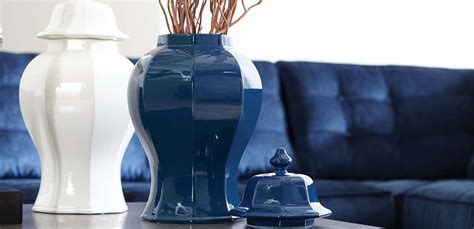What is Ethan Allen Geometric Temple Jar?
The Ethan Allen Geometric Temple Jar is a stunning decorative piece that is bound to add a touch of sophistication and elegance to any room. This beautiful jar is crafted from high-quality, durable ceramic and features intricate geometric patterns and shapes that give it a unique and eye-catching look.
The jar measures approximately 18 inches in height and 9 inches in diameter, making it the perfect size to display on a shelf, mantlepiece or side table. The white and blue color palette is reminiscent of classic Chinese porcelain, adding a touch of timeless elegance to any room.
What sets the Ethan Allen Geometric Temple Jar apart from other decorative pieces is its attention to detail. From the carefully placed patterns to the precision of the shaping, every design element has been carefully considered and executed with perfection. The lid of the jar is also adorned with a matching geometric design, further enhancing its beauty.
This stunning jar can be used in a variety of ways. It can be used simply as a decorative piece, adding a touch of beauty to any space. It can also be used to hold small trinkets or jewelry, adding a functional element to its inherent beauty. Whatever its use, the Ethan Allen Geometric Temple Jar is sure to impress and become a cherished piece in any home.
Frequently Asked Questions about ethan allen geometric temple jar
It is believed they were originally used to hold the ashes of loved ones and adorned the Buddhist temples, thus they became known as “temple jars”. Just like ginger jars, they were eventually used to hold rice, spices, herbs, and salts, among other things, and today, they are mainly used for decorative purposes.
Estimated to be thousands of years old, these jars originated in China in the Qin Dynasty and were placed in temples. In the 19th Century, they began being exported to Europe as decorative objects. The Imperial Landscape Temple Jar features a whole scene painted on its surface.
Originally, ginger jars were used for storing and transporting spices in Ancient China. They were used as containers for salt, oil but also rarer spices such as ginger, hence the name they got when they began entering the Western world. Their utilitarian purpose was replaced in time by a decorative one.
Temple jars are actually the jars that have a protrusion or some kind of decoration on the top and have a more of a fishtail shape. Many say these were originally used to hold the remains of loved ones. Just like ginger jars, however, they were eventually used to hold spices, herbs and salts.
Hebrews 9:4 states that the Ark contained "the golden pot that had manna, and Aaron's rod that budded, and the tablets of the covenant." Revelation 11:19 says the prophet saw God's temple in heaven opened, "and the ark of his covenant was seen within his temple."
Ginger jars are traditionally round, wide in the shoulders with a small mouth and a traditionally domed lid with no additional ornamentation. On the other hand, the temple jar has ornamentation or other type of decoration on the lid and more of a fishtail shape.
Definition. A Temple (from the Latin 'templum') is a structure usually built for the purpose of, and always dedicated to, religious or spiritual activities including prayer, meditation, sacrifice and worship.
The menorah is a lampstand with seven lights on it that never go out, but constantly shine on the loaves of bread as an image of God's light shining perpetually on his people. The altar of incense also burns constantly and represents the prayers of God's people rising up before him.
According to various biblical texts, there were three things in the ark, which are listed in this old text in Hebrews 9:4, "The ark of the covenant [was] covered on all sides with gold, in which was a golden jar holding the manna, and Aaron's rod, which budded, and the tablets of the covenant." This passage from the ...
Ginger jars are a type of porcelain container with a lid that were first used during the Qin Dynasty in China. While beautifully decorated, their purpose was originally more functional as they were used to store herbs and spices.
The primary purpose of the temple is to provide the ordinances necessary for our exaltation in the celestial kingdom. Temple blessings are as essential for each of us as was our baptism. Temple ordinances guide us to our Savior and give us the blessings that come to us through the Atonement of Jesus Christ.
Temples have a more specific purpose. They are places specially set apart for sacred service and ceremonies. They are designated by the Lord and dedicated to His purposes. Temples are the only places where some priesthood ordinances are authorized to be performed.
Menorah, altar, incense stand, showbread table, and more. In antiquity, the Jerusalem Temple was the religious center of Jewish life. The primary activity of the Temple was offering sacrifices - animals, grains, wine and more - to God.
6 Symbols of the Ancient Tabernacle
- Altar of Sacrifice. Professor Parry: The law of Moses included a complex set of sacrificial offerings, which were given at the tabernacle's altar of sacrifice and, later, in the temple in Jerusalem.
- Laver.
- Menorah.
- Table of Shewbread.
- Altar of Incense.
- Ark of the Covenant.
- 50 Going Forth.














